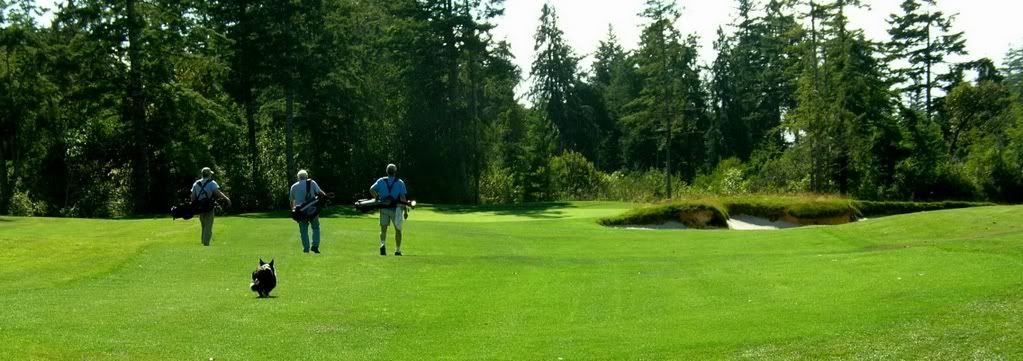I was born in Oregon so I am qualified as a certifiable expert . . . with sortie opinions that flare up beyond her borders. I know what a geode, a pseudotsuga menziesii, and a Western Meadowlark is. Beyond that though, I just know what I like.
What I like about Bandon Crossings . . .
There is wind. Not the likes of Bandon at its shores but winds to keep the slicer and flopper concerned.
Its routing is on tough but golfable terrain. It is unique and appropriate for the land. The two greens in the lowlands were the only greens needing material brought in (from the property sand quarry) that I know of.
Land cut and fill was done only where land was not golfable and within regulations of environmental agencies.
It has an open feel, even in the trees. I believe this comes from the groving of tree stands as opposed to tree-lined from end-to-end fairways. There are inescapable dense stands but they are only on one side of a few holes, thus not trunk-space clausterphobic crushingness.
The trees are beautiful here. And not nude-looking as most newly cleared swaths of timberland edges seem to be. Hats off to Tony Russel for his input of controlled tree removal. The trees and shrubs are native, as well. Madrones, silver fir, Sitka spruce, shore pines, chittum, manzanita, and more, give a full pallette of life beyond the turf.
There is minimal mounding - the ground was already heaving with action before the machines rumbled.
The tall grasses are active and colorful in the wind. I'm not sure what their strains are but I think there's Timothy grass (old cattle feed) in abundance. Mowing patterns will be adjusted as future play dictates. My "wayward" play happened to "adjust" things rather extensively, at least hypothetically. The fairways are generally wide there but there is no limit to my errantness.
As Peter stated, the 5 par 3's are great. . .
The 6th is a stunner to look at with a strong blend of anticipation after a long walk, (it descends from the tee), timeless bunkering, a beautiful grove of trees in the background, and a kaleidoscopic peek of the course ahead.
The 9th is a subtle but favorite of mine that has a large bunker ahead of a semi-blind green that has a good amount of landing area behind it to allow for some suspenseful bounding to the green. The green is only visible at the left 1/4 and appears flattish from that POV but it undulates and slopes tremendously with a center ridge and fall away to middle right - right off the green.
The 11th is a Re-Dan. Let's be honest, there's only one Redan but every designer has made their own variation. This one works both visually as unique and fitting the land, and traditionally as one that favours a draw from a brow sloping to the green.
The 14th tees from a high crest to a lowland green is an interesting drop shot of considerable distance. Study the flag, the trees, the grasses because the winds can feel strong on the ridge, swirl and eddy on the way down, then calm at the green . . . or ?
The 16th is a par three with, visually, a sliver of a green. Its very wide but not deep with a comforting backboard beyond. There are two bunkers on the left - one front, one back, so if the flag is between them, it's a sucker's gamble.
*********************************************
I especially like the entrance to most of the greens as they are equal in height or HIGHER than the green itself. Thus we have invitations to use the land to approach greens and not the insipid raised greens that require the aerial assault. Here there is the much sought-after and lost design of the green being an extension of the fairway. Part of this is the soil the course is on - high sand content, part of it could have been budget constraints, and surely part is the decision to give the option. Except for #'s 4, 5, 14, and 17, I think all others allow for the ground approach if not encourage it.
The bunkering is of highest quality and visually enticing. It is not redundant nor excessive. It is well-considered and play-affecting. All bunkers are filled with sand from on-site. They are memorable.
Aside from the unavoidable long walks from 5 to 6 and 14 to 15, every other hole is nicely spaced between them. I cannot imagine it ruining a players round for this slight lapse of golf time. We walk 4 to 5 miles in a round, what's another couple hundred yards? Remember when we had to flip records over . . . it's kind of like that. You make the effort and you'll be rewarded with more music.
The corral adds history to the land. It beckons to be noticed and I cannot help but think of the lives of bygone ranchers, timbermen and their families.
There's plenty to like at Bandon Crossings and curiosity alone should lure the adventurous to swing the sticks, but the words of others won't bring anybody back. It has to speak for itself. If its message reaches you as truthful, then the story it tells becomes worthy of retelling.
"Son. Don't ever ask a man where he's from. If he's from Oregon, he'll tell ya. If he ain't, don't embarrass him." UNK

9th hole Par 3
Milo the dog keeping the pace of play going. Heck, he's walked this courses 100's of times with 6 inch legs. What a stud.
BTW... No flagsticks were placed yet when I played. So, though most of green is blind, you will see flag when you play. Sort of like the white rock at "The Dell".